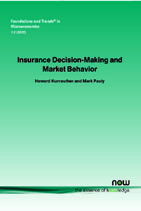Insurance Decision-Making and Market Behavior
By Howard Kunreuther, University of Pennsylvania, USA | Mark Pauly, University of Pennsylvania, USA
Abstract
Considerable evidence suggests that many people for whom insurance is worth purchasing do not have coverage and others who appear not to need financial protection against certain events actually have purchased coverage. There are certain types of events for which one might expect to see insurance widely marketed that are viewed today by insurers as uninsurable and there are other policies one might not expect to be successfully marketed that exist on a relatively large scale. In addition, evidence suggests that cost-effective preventive measures are sometimes not rewarded by insurers in ways that could change their clients' behavior. These examples reveal that insurance purchasing and marketing activities do not always produce results that are in the best interest of individuals at risk. Insurance Decision-Making and Market Behavior discusses such behavior with the intent of categorizing these insurance "anomalies". It represents a first step in constructing a theory of insurance decision-making to explain behavior that does not conform to standard economic models of choice and decision-making. Finally, the authors propose a set of prescriptive solutions for improving insurance decision-making.
Insurance Decision-Making and Market Behavior
Considerable evidence suggests that many people for whom insurance is worth purchasing do not have coverage and others who appear not to need financial protection against certain events actually have purchased coverage. There are certain types of events for which one might expect to see insurance widely marketed are now viewed today by insurers as uninsurable and there are other policies one might not expect to be successfully marketed that exist on a relatively large scale. In addition, evidence suggests that cost-effective preventive measures are sometimes rewarded by insurers in ways that could change their clients' behavior. These examples reveal that insurance purchasing and marketing activities do not always produce results that are in the best interest of individuals at risk. Insurance Decision Making and Market Behavior discusses such behavior with the intent of categorizing these insurance "anomalies". It represents a first step in constructing a theory of insurance decision making to explain behavior that does not conform to standard economic models of choice and decision-making. Finally, the authors propose a set of prescriptive solutions for improving insurance decision-making.
